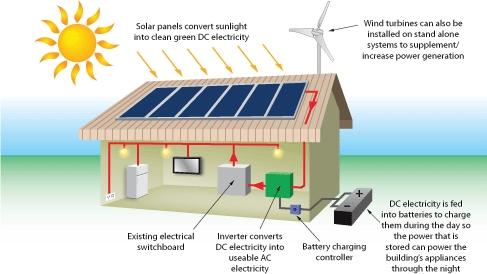
Credit: Cherry Affordable Homes
Disconnecting from the commercial electric grid is a popular idea — generate enough electricity to supply all domestic (& sometimes transportation), needs from private, renewable, sources. In a rural setting, energy independence is, in some cases, essential. In a suburban setting, not essential, but for some, desirable. What follows is a discussion of in-principle considerations for leaving the grid.
1. Reduced grid is easy. A growing number of households are doing this — solar hot water + a few solar (photovoltaic — PV) panels on the roof feeding into the grid
2. Getting off the grid 90% is fairly easy, but requires
a. $$$
b. lots of PV
c. storage
3. 100% off the grid
a. the hard way — requires:
i. $$$
ii. some combination of:
1. PV over-capacity to generate useful amounts of power on overcast days
2. storage
3. some other generation capacity (internal combustion engine (ICE) genset, fusion reactor, etc.) for when a prolonged period of overcast days finally brings the renewables grinding to a halt — problem is, actually using the ICE genset would erode the environmental & financial benefits of the above, & the fusion reactor remains stubbornly 50 years in the future
b. the other hard way:
i. as for, “the hard way”, plus
ii. geographic diversity — place some PVs in other physical locations so that if the Sun isn’t shining at your house, it will be shining at your other locations — a few hundred kilometres away would be good — make some of them at least a thousand kilometres — add some wind too
iii. 3.b.ii. “geographic diversity”, immediately above, will reduce or eliminate the need for 3.a.ii.3 “some other generation capacity”, in, “the hard way”1
iv. wires, poles, transformers etc. to connect your geographically diverse electricity facilities
c. the other other hard way:
i. as for “the other hard way”, but
ii. achieve geographic diversity by entering into co-operative arrangements with like-minded people who own the means of generation in their area
iii. wires, poles, transformers etc. to connect geographically diverse electricity facilities & distribute power to/from members of the co-operative arrangements as necessary
iv. accounting/billing system to allow for cash adjustments between parties to the co-operative arrangements depending on their production/consumption
v. 3.c.iv. above will, with little adjustment, allow inclusion of others who wish to receive electricity as a paid-for service
Umm …
Actually ... come to think of it ... the first two 100% off-the-grid systems sound too expensive &/or difficult &/or environmentally unsound, & the last, “3.c. the other other hard way”, sounds like what first world countries have already, with geographic diversity & other features provided by the existing grid.
Use of the existing grid in this way allows utilisation of grid scale storage, where available, such as pumped hydro storage in the Snowy Mountains, Australia2, & Foyers Power Station, Loch Ness, Scotland3, for at least a part of the storage required.
Umm … & with unsubsidised renewables now cheaper than new coal4,5,6,7, a sustainable grid seems inevitable, if our technological society can survive the problems it now faces (including old coal) until the sustainable grid arrives.
Best thing to do, in a typical first world domestic situation, to facilitate a renewable grid, is somewhere in the range 1. “Reduced grid”, & 2. “Getting off the grid 90%”.
__________
1 "Renewable energy is ready to supply all of Australia's electricity" http://hhg2tech.blogspot.com.au/2014/07/renewable-energy-is-ready-to-supply-all.html
2 "Ramping up hydro pumped storage schemes": http://ecogeneration.com.au/news/ramping_up_hydro_pumped_storage_schemes/075440/
3 Foyers Power Station, Loch Ness http://schulen.eduhi.at/kultfor/eee/energy/energy/foyersps.htm
4 Giles Parkinson: “Renewables now cheaper than coal & gas in australia”, 7 February 2013, http://reneweconomy.com.au/2013/renewables-now-cheaper-than-coal-and-gas-in-australia-62268
5 Beyond Zero Emmissions: “In Australia, Wind Power Is Already Cheaper Than Fossil Fuels, & Solar Is Right Behind”, http://bze.org.au/media/newswire/australia-wind-power-already-cheaper-fossil-fuels-and-solar-right-behind-130211
6 Solar Market: “Renewable Energy Now Cheaper than Coal”, https://www.solarmarket.com.au/renewable-energy-now-cheaper-than-coal/
7 Mike Calise, Head of Electric Vehicle Solutions for North America at Schneider Electric, interviewed by Michael Kent on Charged EVs: "Unsubsidized solar is already cheaper than retail electricity prices in many markets around the world: Australia, Chile, Germany, Italy, India (according to Seba’s book, Clean Disruption)." http://chargedevs.com/features/evs-renewables-energy-storage-the-unstoppable-trio-of-energys-future/ / searchkeys /